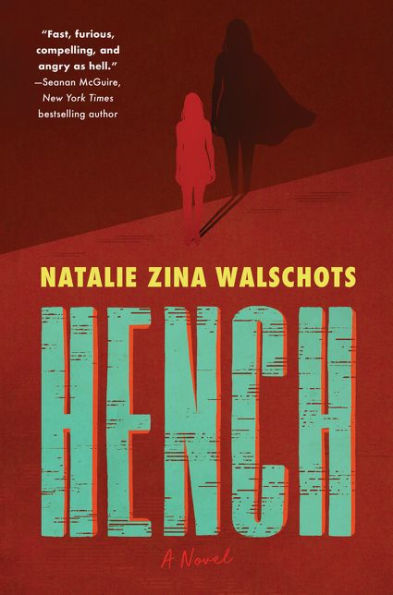Pop culture and superheroes go hand-in-hand. There’s the Marvel Cinematic Universe, of course, and so many reboots and reincarnations of Batman over the years that I’m daunted by the task of counting them all. Hench’s main character, Anna, however, would likely know the number–she’s a spreadsheet aficionado who lives in a world much like ours except that superheroes and supervillains are real, an almost mundane addition to everyday life.
Superheroes and supervillains, however, aren’t all they’re cracked up to be in Anna’s world. And in this vein, Natalie Zina Walschots’ Hench is similar to the comic book series and recent television adaptation of The Boys, where a corporate conglomeration uses superpowered people as (among other things) a product to sell to the masses.
The Boys paints a darker picture of how injecting superpowered people into society would actually play out, but the story Walschots tells us is far from rosy. In Hench, we follow the journey of Anna, a number-cruncher who works for a temp agency that provides staffing support for villains. (Similar to The Boys, the superpowered heroes and villains each have organizational enterprises that shape and influence their impact on society.)
At the beginning of the novel, Anna is a nobody. And like many of us fellow nobodies, she is largely unmotivated by the day jobs she jumps from. She also has no real friends except for June, a moderately-powered person who the temp agency assigns to villains who can take advantage of her superheightened sense of smell.
Buy the Book


Hench
But then Anna’s life takes a turn when her first stint at fieldwork leaves her with a shattered leg after a run in with Supercollider, Earth’s “greatest” superhero. Her life falls apart even as she slowly recovers with the help of June, and it’s here she realizes (after extensive data analysis and multiple spreadsheets) that heroes create more harm than benefit to the world. This conclusion becomes the bedrock of Anna’s new worldview and one of the main drivers (her relationship with her new supervillian boss, Leviathan is the other one) of who she eventually becomes.
Great superhero comics have long explored different themes and trends that impact our society. Hench also does this quite well, and uses the existence of superpowered people to show the well-explored comic book premise that superheroes and supervillains are two sides of a coin, where one is not likely to exist without the other (see Batman and the Joker as Exhibit A). This duality is a well-trod idea, yes, but it’s one that remains relevant, and Walschots’ brings a fresh take to it.
Walschots also uses superpowered people to explore another issue in our life that has gotten less coverage in comic books—how data analysis can allow society to count the impact certain actions or policies can have on the world. Although Anna may disagree, these calculations can never be an exact science (is there a definitive cost to losing a human life?), but they can be a tool to help society determine what policies to enact and, on an individual level, what actions we take ourselves. What Anna also doesn’t see is that this weighing of benefits and costs will always be messy, as all of us in these pandemic days know first hand; everything—from the simple act of going to the grocery store to seeing loved ones in person—must now be weighed against the risk of spreading and/or contracting a deadly virus.
Anna crunches the numbers for superheroes “heroic” actions and finds they come up short–the good guys are causing more harm than good. Perhaps because Anna initially sees her superhero analysis in black-and-white terms (and perhaps because she has been seriously injured by one), she decides that, according to the numbers, the superheroes need to go, even if doing may cause Anna to cause some harm of her own in the process.
Hench explores the moral murkiness of Anna’s journey. It’s told from Anna’s point of view, and as such, much of the damage she causes takes place off the page (Anna hates doing fieldwork, after all). One could argue that this breaks the overused adage that books should “show, not tell,” but it works here—it’s easier to greenlight horrific acts if you can remain separate from it, and when Anna does become part of the action, the impact of how far she’s gone hits harder.
Things get messy at the end of Hench (very messy: content warning for body horror), and some things do wrap up in a definitive way. And while what happens in the last part of the novel isn’t exactly what Anna expected, it is the ending that the book has teed up—there’s resolution, but not a definitive conclusion or answer to the issues Hench poses. That’s okay though—like many good books, reading Hench leaves you with questions and concepts that will linger after the last page is read. And while there’s potential for Walschots to write a follow-up book in this world, Hench is rich enough to digest on its own, an enjoyable read whether you’re already a huge fan of superhero stories or new to the genre.
Hench is available from William Morrow.
Vanessa Armstrong is a writer with bylines at The LA Times, SYFY WIRE, StarTrek.com and other publications. She lives in Los Angeles with her dog Penny and her husband Jon, and she loves books more than most things. You can find more of her work on her website or follow her on Twitter @vfarmstrong.










